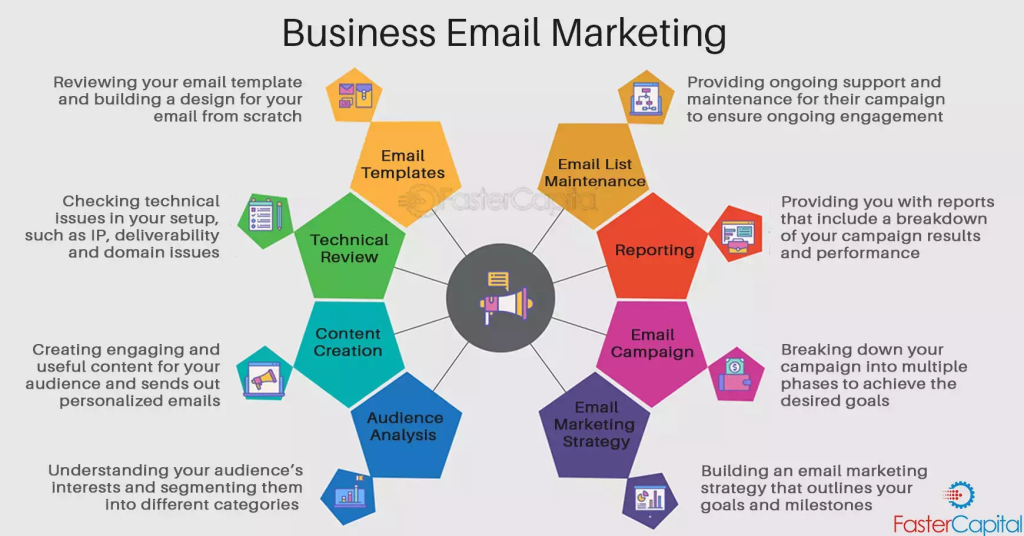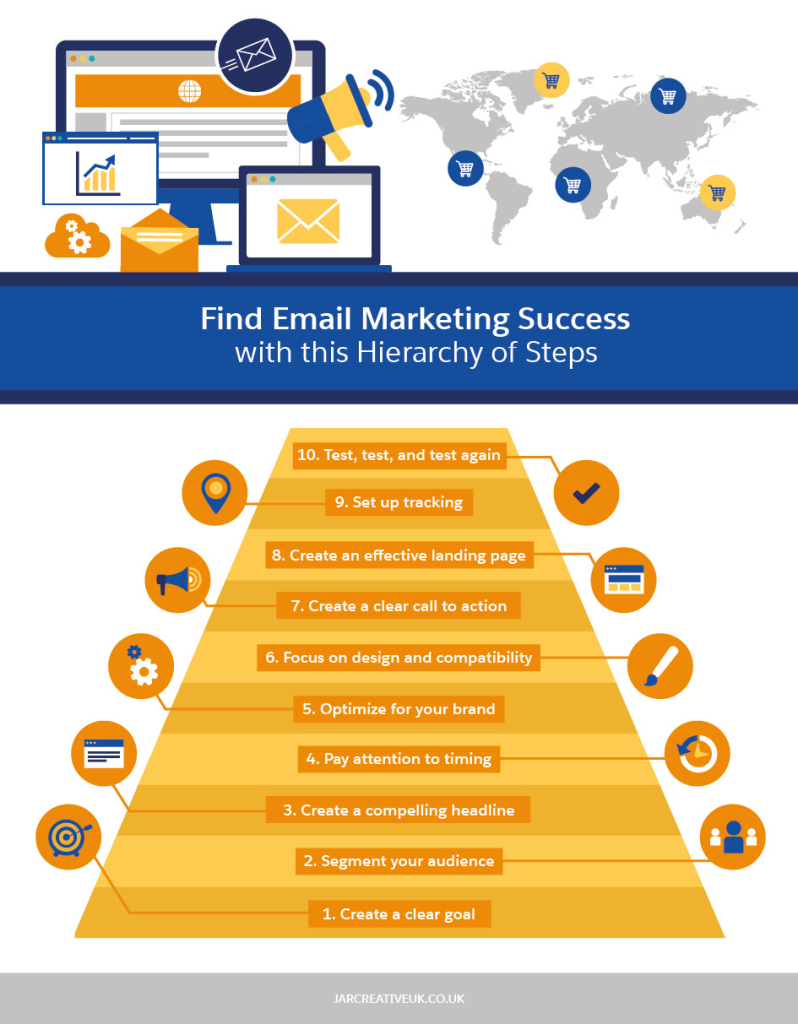Email marketing

Email marketing is a crucial strategy for businesses, involving the sending of emails to current and potential customers to boost brand awareness, engagement, lead nurturing, and sales. With over 4 billion email users globally, representing more than half of the world’s population, email is a powerful and widespread communication channel. In 2022, the average return on investment (ROI) for email marketing was an impressive $36 for every $1 spent, highlighting its effectiveness as a marketing tool. Ignoring or neglecting email as a business is not advisable given its widespread reach and high ROI potential.
Email marketing Campaign
An email campaign is a targeted series of marketing messages sent to a group of recipients with the aim of promoting a product, service, or business. The goal is to encourage recipients to make a purchase or learn more about the company. Effective email campaigns play a crucial role in business growth, traffic generation, and sales increase. Key elements of successful email campaigns include a compelling subject line to grab attention, content that is easy to read and mobile-friendly, relevance to the recipient’s interests, and personalized content. The best campaigns also provide clear value to recipients, outlining what they gain from engaging with the product or service. Collecting data on campaign performance allows businesses to refine their strategies for optimal results.

Executing email marketing campaign
Now that we understand the significance of email marketing campaigns, let’s explore the execution process. Implementing a successful email campaign involves strategic planning and can be facilitated by utilizing email campaign templates. These templates serve as valuable guides in creating effective email marketing campaigns tailored to your business. To execute a campaign successfully, consider factors such as a compelling subject line for initial engagement, ensuring the content is easily digestible and mobile-friendly, personalizing the message to cater to the recipient’s interests, and emphasizing the value of the product or service. Utilizing templates streamlines the process, making it more efficient and increasing the likelihood of achieving campaign goals.

- Identify your audience
Before launching email marketing campaigns, it’s crucial to identify your audience. Understanding your brand’s demographic is essential for creating personalized and targeted emails that resonate with recipients. Tailoring campaigns to specific segments of your audience increases the likelihood of engagement, as subscribers are more inclined to open emails that feel individually crafted for them. Take the time to thoroughly identify your target audience before proceeding with other steps in the email marketing campaign process.
Types of E-mail Campaigns are:-
- New Product Announcement Email:
- Aimed at introducing and creating awareness about a new product or service.
- Event Invitation:
- Used to invite recipients to participate in an event, such as a webinar, conference, or product launch.
- Re-engagement Emails:
- Designed to reconnect with inactive or disengaged subscribers to revive their interest and interaction.
- Promotional Campaigns:
- Focus on promoting discounts, special offers, or sales to encourage immediate action from the recipients.
- Welcome Emails:
- Sent to new subscribers or customers, providing a warm welcome and introducing them to your brand, products, or services.
2. Send your emails at the right time
Before sending out your email campaign, it’s crucial to consider the timing of your emails. Choosing the right time enhances the chances of your emails being opened and engaged. Avoid sending emails too early or late in the day. Studies suggest that optimal times for sending emails are on Tuesday, Wednesday, and Thursday, particularly at 10 am, 2 pm, or 8 pm. This strategic timing increases the likelihood that your audience will notice and engage with your email, maximizing the effectiveness of your campaign.
3. Define Your Goals
In an email marketing campaign, it is essential to clearly outline specific objectives. Whether the goal is to increase sales, drive website traffic, build brand awareness, or engage with the audience, having well-defined goals is crucial for guiding the overall strategy. These objectives provide a roadmap for crafting targeted content, designing effective campaigns, and measuring the success of email marketing efforts.
4. Understand Your Audience
In an email marketing campaign, understanding your audience is key. This involves segmenting your email list based on demographics, behaviors, or preferences. By tailoring messages to different segments, you ensure that the content is highly relevant and resonates with each specific group. This segmentation strategy enhances engagement and increases the likelihood of achieving the campaign’s goals by delivering personalized and targeted communication to different audience segments.

5. Build a Quality Email List
In an email marketing campaign, building a quality email list is crucial. The focus should be on cultivating a list with engaged subscribers. Utilize opt-in forms strategically on your website, social media, and other touchpoints to encourage people to subscribe willingly. It’s important to avoid purchasing email lists, as this practice can harm your sender’s reputation and result in lower engagement. A high-quality email list ensures that your messages reach an audience genuinely interested in your content, increasing the effectiveness of your email marketing efforts.
6. Craft Compelling Content
In an email marketing campaign, crafting compelling content is essential. The content should provide value to your audience, whether it’s informative, entertaining, or promotional. Ensure that your content is well-written, visually appealing, and consistent with your brand voice. By creating engaging and valuable content, you enhance the likelihood of capturing your audience’s attention and achieving the goals of your email campaign.
7. Personalize Your Emails
In an email marketing campaign, personalization plays a crucial role in boosting engagement. Utilize recipient names, recommend products based on past purchases, and tailor content to individual preferences whenever possible. By incorporating personalization into your emails, you create a more customized and relevant experience for recipients, increasing the likelihood of capturing their attention and fostering a stronger connection with your brand.
8. Choose an Engaging Subject Line
In an email marketing campaign, selecting an engaging subject line is critical for encouraging recipients to open your emails. It should be concise, compelling, and relevant to capture attention. Consider A/B testing different subject lines to identify what resonates best with your audience. The subject line serves as the first impression and plays a key role in determining whether recipients will engage with the email content, making it a crucial element in the success of your campaign.
9. Mobile Optimization
In an email marketing campaign, mobile optimization is crucial. Ensure that your emails are mobile-friendly, as a significant portion of users open emails on their mobile devices. It’s essential to test your emails across various devices and email clients to guarantee a consistent and visually appealing experience. Mobile optimization is key to reaching and engaging a broader audience, as it ensures that your email campaigns are accessible and effective across different devices.
10. Use a Clear Call-to-Action (CTA)
In an email marketing campaign, using a clear Call-to-Action (CTA) is crucial. Guide your recipients on the specific action you want them to take, whether it’s making a purchase, downloading a resource, or visiting your website. A clear and compelling CTA improves conversion rates by providing a straightforward path for recipients to follow, increasing the effectiveness of your email campaign in achieving its goals.
11. Test and Optimize
In an email marketing campaign, testing and optimization are essential. Regularly test various elements like subject lines, content, images, and CTAs. Analyze the results to gain insights and use this data to optimize future campaigns. This iterative process ensures that your email marketing strategy evolves based on what resonates most effectively with your audience, ultimately improving the performance and impact of your campaigns over time.
12. Monitor Analytics
In an email marketing campaign, monitoring analytics is crucial. Keep a close eye on key metrics such as open rates, click-through rates, conversion rates, and unsubscribe rates. Analyzing these metrics provides valuable insights into the effectiveness of your campaigns, allowing you to make data-driven decisions. Regularly reviewing and interpreting analytics helps you understand how well your emails are performing and enables you to make informed adjustments for ongoing improvement in your email marketing strategy.

13. Comply with Regulations
In an email marketing campaign, compliance with privacy and anti-spam regulations is essential. Ensure that your campaigns adhere to regulations like GDPR and the CAN-SPAM Act. Provide clear opt-out options, respect subscribers’ preferences, and maintain transparency in your data practices. Adhering to these regulations not only fosters trust with your audience but also helps you avoid legal issues associated with improper email marketing practices.
14. Build Relationships
In an email marketing campaign, building relationships with your audience is a primary goal. Utilize email as a tool to consistently provide valuable communication, fostering trust and loyalty. By delivering content that resonates with your audience and addressing their needs, you strengthen the connection between your brand and subscribers. Building and nurturing relationships through email marketing contributes to long-term customer loyalty and engagement.